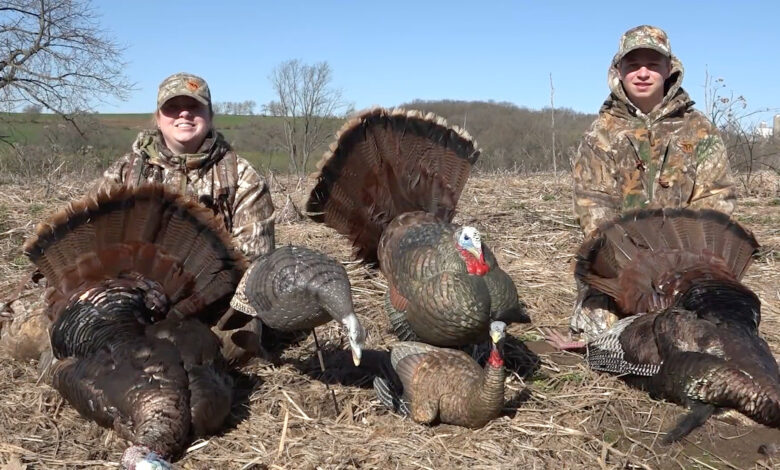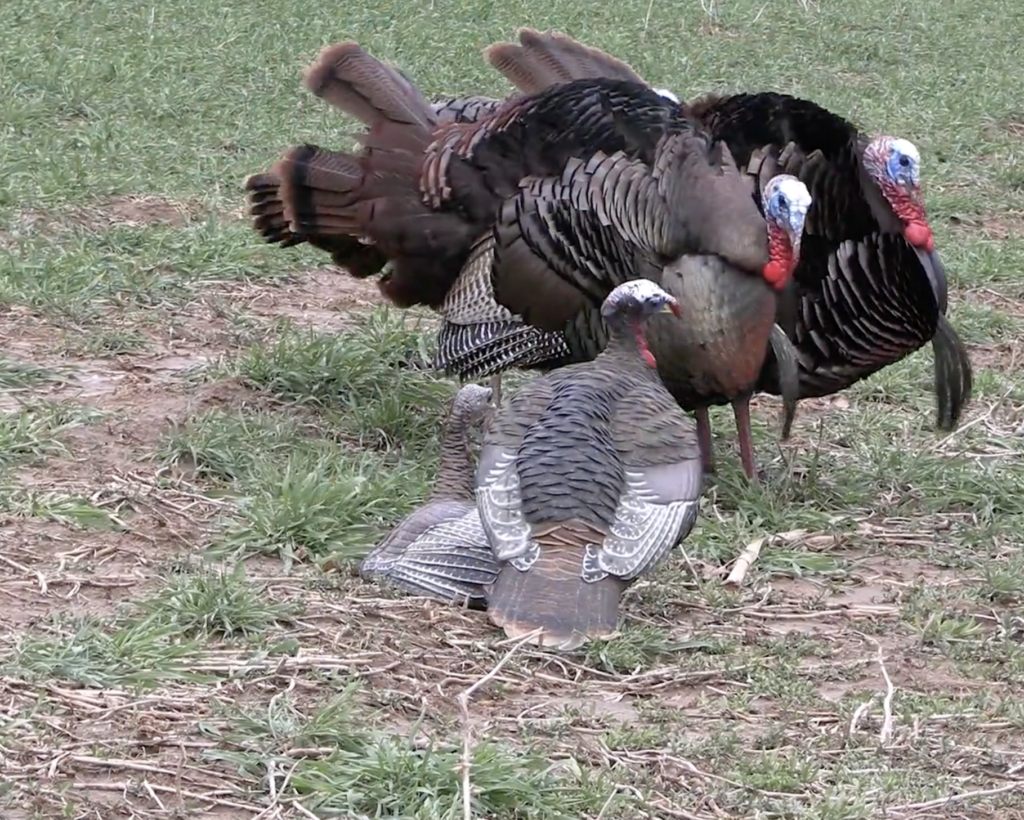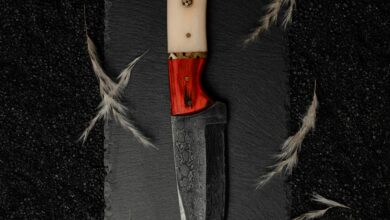Understanding Turkey Strutting and What It Means

I remember the first time I observed the stiff and confident walk of a strutting turkey with its puffed-up appearance. It was in Nebraska and sitting on the ground-blind, I regretted that I did not have the camera with me.
After many seasons, I have familiarized myself with the act of turkey strutting. Nonetheless, I never find the display anything less than striking.
But why do turkeys puff up?
We will answer that question and also discuss how hunters can use turkey behavior to their advantage.
Check out this episode of “Own The Season” from Tyler Goebel and Kyle Thompson to learn more about full strut decoys and turkey strutting.
What is Turkey Strutting?
Turkey strutting is how turkeys find a mate for breeding. A strutting turkey walks with a slow gait with the head held high, feathers puffed, tail fanned and wings lowered.
You may know that strutting is not unique to turkeys. Other birds like the peafowl and the ruffed grouse perform this fascinating act too. Here are some other physical changes that you will observe during a strut.
- The face is stretched out exposing the red, blue, and white colors
- The wings drop, allowing the wing feathers to touch the ground
- The back and the breast feathers stand erect, making the bird appear larger than it is
- While the head and neck can turn from blue to bright red, the crown usually remains white
- An increased blood flow to the snood–the fleshy protuberance over the beak– makes it elongate
Strutting is mostly observed in the spring turkey mating season as a part of establishing social dominance and attracting the hens. Usually, the strut is accompanied by drumming or spitting sounds to make things more attractive for the hens. I have also heard veteran hunters identifying the wing-dragging sound of a strutting turkey, especially in dry and rocky terrains.
The strutting mechanism is controlled by the small muscles at the base of the body feathers and in the tail. These muscles contract to make the feathers stand erect. Likewise, turkeys can contract or relax the small blood vessels in their neck and head. The change in blood flow causes the skin color changes.
The strutting period can last from a few minutes to more than an hour, depending on the situation. Most gobblers strut when the hens are around, but you may find a few loners that are wandering through the forest in full strut. These loners are desperate in search of mates and are easy to attract by using the best turkey decoys.
A few hunters have observed hen turkeys strut their feathers too, but that is a rare occurrence. It is usually a response to another aggressive hen or any other strong stimulus. A predator threatening a brood of chicks can be a reason.

Why Do Turkeys Do This?
If you are wondering why turkeys strut, the answer is simple. Fanning the tail feathers and showing off the plumage is a courtship ritual that is a part of the male turkey’s innate behavior.
In fact, turkeys can begin strutting and fanning out their feathers at the age of three to four weeks. The idea behind showing off its features is to impress a female and increase the chances of mating.
The male turkeys begin their courtship ritual even before the hens are ready to breed. It is only after the first phase of spring that the hens start showing interest. Ultimately, one of the hens will accept the gobbler’s advances and the actual breeding ritual will begin.
Does this attract the hens? In reality, it does work. After all, performing this energy-intensive task multiple times a day indicates that the male bird is in good health.
Strutting to establish dominance in a group of birds is another reason behind the act. Watching two mature gobblers strutting and engaging in a fight is a spectacular sight.
Once a tom can attract a hen in a favorable location, he tends to come back to the same place to perform the activity again. This leads to the development of a “strut zone”–an area where they frequent. Locating these zones while scouting for turkeys will help you use the decoys for maximum effect.
When Do Turkeys Strut?
Even though turkey strutting is mostly observed during the breeding season, you can locate strutting turkeys in other seasons too. The objective is to display dominance over the other males. And the optimist gobbler might be looking to put up a show in front of the hens for an off-season mating opportunity.
It is not that gobblers prefer particular terrains for strutting. Usually, they pick open locations that receive plenty of sunshine. That way, they can observe the hens and look out for any signs of approaching danger.
How Do You Know if a Turkey is Angry or Territorial?
The old toms can be deceptive once they have detected your movement or an outline that does not match the natural pattern. They will turn around slowly, appearing to make a natural movement.
Then, without a warning, they will swiftly melt into the woodlands. Reading the turkey’s body language right can be a great advantage for a hunter in such scenarios.
In my experience, the twitching of the wings is one sign that indicates that the bird is aggravated. The other obvious sign is the change in head coloration. If the head color is white, light red, or blue, the bird is relaxed.
But, what if you see a bird in full strut stopping its charge at the turkey decoy setup and his head turning dark red?
In that case, assume that he is angry or his turkey sense is tingling. More than once, I have seen a gobbler stop and observe the turkey decoy setup from a distance with some nervousness. Then he spun around and beat a retreat.
Another sign is the length of the snood. If the snood is fully elongated and swinging with each step of the strut, the tom is relaxed. Once the snood starts shrinking, the bird is being watchful. If it shrinks completely, exposing the beak, the tom is as nervous as a squirrel in traffic.
In case the bird is within the shotgun range, make the shot now! Chances are, his sixth sense is screaming louder with each passing second. If he is beyond the shotgun range, you can try a wounding shot, which is a bad idea. The chances of getting closer to the bird without it noticing are very low too. The best option is to save your shell for another time.
Final Thoughts
The mating ritual of turkeys is a fascinating act and strutting is a visual spectacle that makes chasing old toms even more fun. That said, a lot of scientific research on strutting and drumming still needs to be done.
But remember, that these are wily birds that will test your patience. So when your hand is on the trigger, do not get distracted by turkey strutting. Look out for the signs that will help you use the situation to your advantage.
The secret to punching more gobbler tags is perfecting the art of listening and observing while being still.


